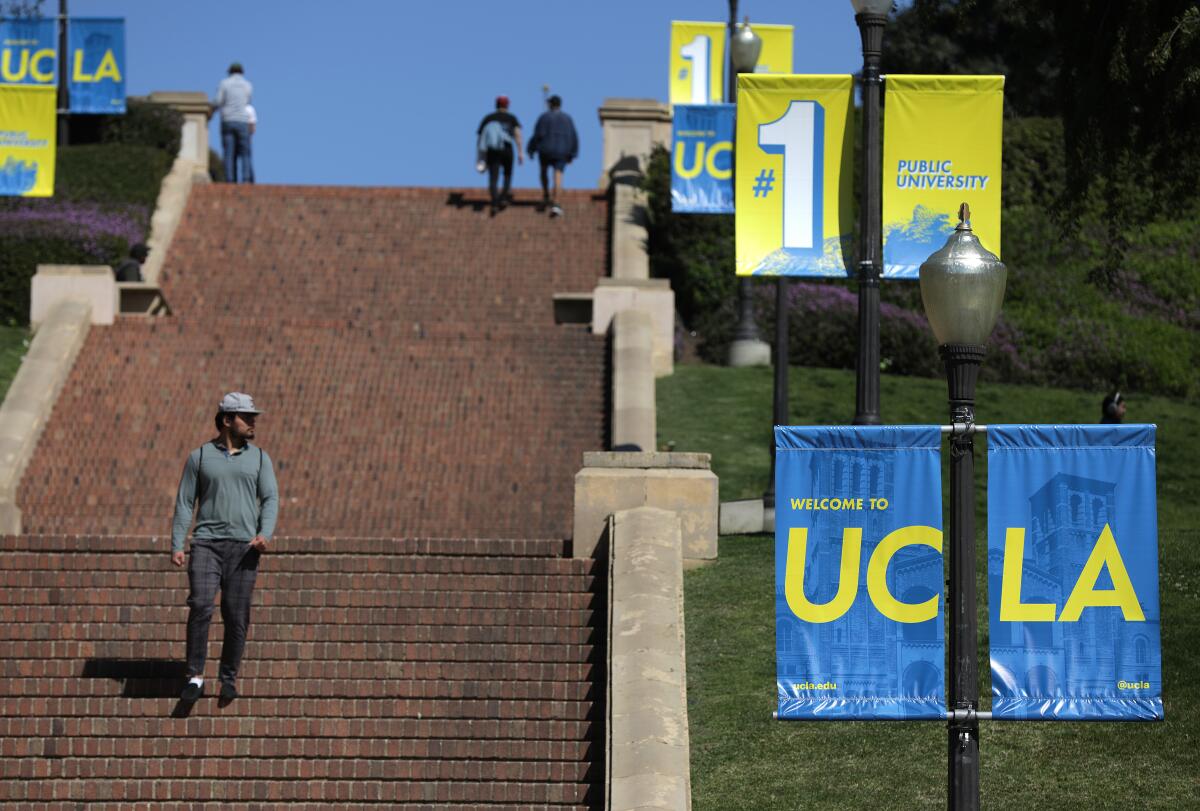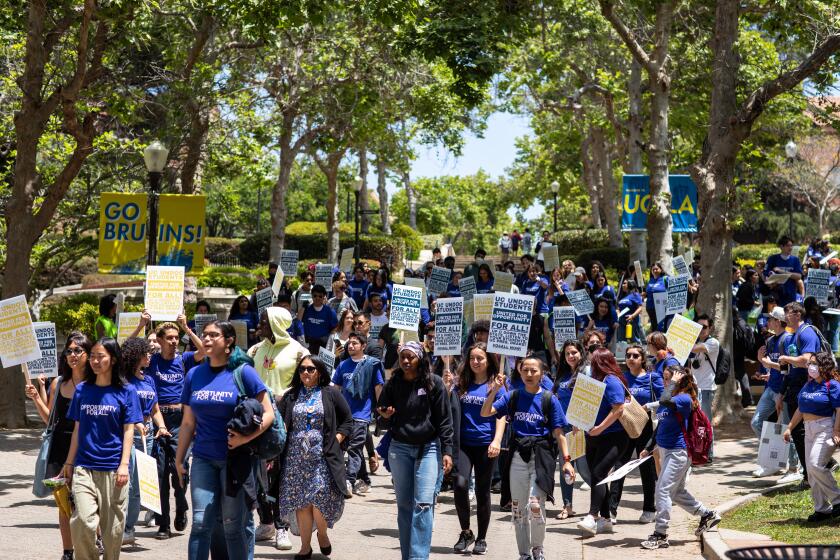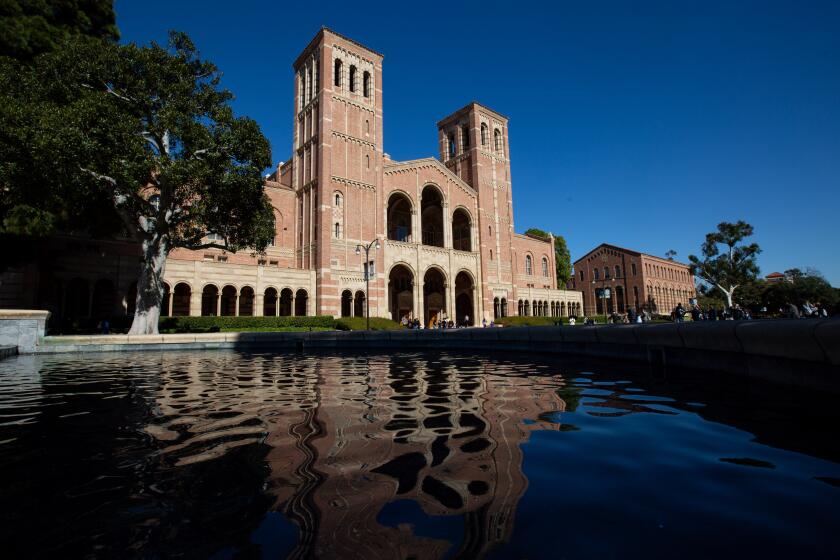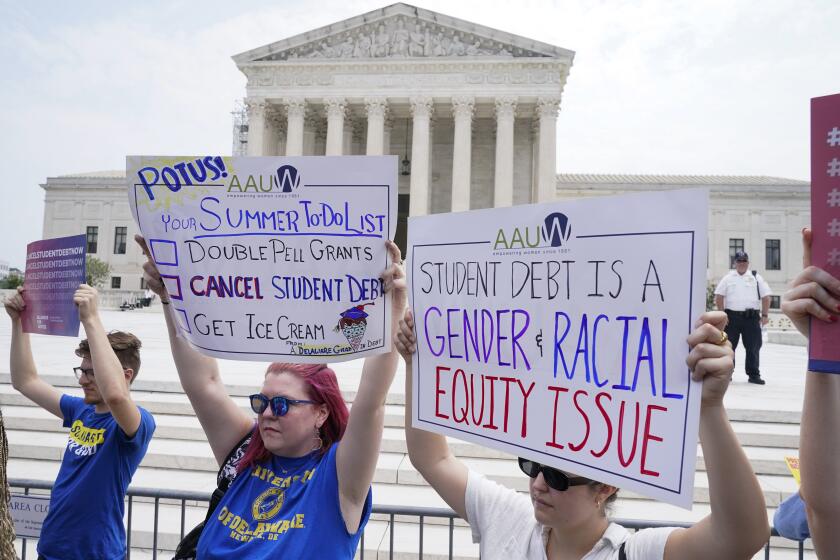Opinion: The American university system is reviled at home but envied around the world. Why?

- Share via
Once again this fall, about 1 million international students — and it would be more, if we let them in — have flocked to American colleges and universities. Indeed, it seems that what the world still most wants from us, besides our pop stars, fast food and weapons, is a place on a U.S. campus.
But back at home, Americans hold their higher education system in much lower regard. Though we have been the worldwide leader in teaching and research for decades — just look at who keeps winning Nobel prizes — many Americans blame our colleges and universities for the nation’s ills, including financial distress and cultural collapse.
Opinion: College students were ‘woke’ in the 60s and annoying to their elders. Meet their successors
When conservatives denounce campus progressives and radicals as out-of-touch elites, when liberals bemoan failures to defend free speech, and when both denounce cancel culture, we can hear the echoes of the 1960s.
In fairness to its homegrown detractors, the American system of higher education does have itself to blame for many of the brickbats coming its way. For one thing, rather than a real system we have a profit-based anarchy, with about 5,000 colleges and universities following their own paths into or out of chaos. Exhibit A of this chaos is the student debt crisis. Despite recent efforts at governmental intervention, including a Biden administration initiative struck down by the Supreme Court, thousands of students today face more than $1.7 trillion in debt, much of it from gouging by for-profit institutions. Administrator positions and salaries have exploded, teaching loads have shrunk and campuses increasingly look like resort hotels.
Prestige and a place in academic or athletic rankings have proved just too tempting for boards of trustees to pass up — aided and abetted, of course, by some parents’ willingness to pay the ever-rising price of admission.
Why, then, have American universities and their faculties been the global gold standard since the end of World War II? Why, in spite of endless and often justified criticism from within this country, is the United States still the envy of the world in higher education?
Ironically, much of the answer is due to the same lack of structure that introduces chaos into the system. We have higher education unlike any other in the world. It may seem — and often is the case — that the incompetent are leading the ungovernable. But that anarchy, that freedom, which exists nowhere else in the world, is the very thing that makes our universities so enviable.
Most Californians say the University of California and California State University are unaffordable, and value community college and skills training.
Consider the fact that most American college and university administrators have little or no managerial training in running a department, laboratory, school or university. While in many countries the faculty are civil servants who work for the state and have to ask permission to take a position at another university, ungovernable American faculty believe they work for no one but themselves. They often will switch campuses at the drop of a new laboratory or a more attractive salary.
That free-wheeling independence is also the source of their dynamism. A big part of what draws international students to American college campuses is the ability to take risks. Our campus freedom is, in large part, the freedom to make mistakes.
The difference between our and other systems extends to the students. In most other developed nations, a course of study is determined at the start of university. Your path is chosen and that, for the most part, is your life: no waste, no errors, no changing direction. In the United States, meanwhile, many freshmen’s major is “undecided.” We take immature students and tell them to major in something they love — don’t worry about a job, because their first one may not even have been created at the beginning of their last year of study. We call the concluding ceremony after four years “commencement” as if it’s the beginning of your education.
A new, income-based student loan repayment plan launched Tuesday offers more affordable monthly payments to millions of low- and moderate-income borrowers.
Within the great patchwork of American higher education, one state stands out. In no small part, the system that thrives today originated with Clark Kerr, the visionary of universal college education. The California Master Plan for Higher Education, which Kerr designed in 1960, permanently landed UCLA and UC Berkeley atop the nation’s — and world’s — research university pyramid. Kerr also boosted both the research capacity and graduate programs of other UC campuses, including Santa Barbara, Irvine, Davis and Riverside.
And to further advance his goal of universal higher education, Kerr proposed dozens of two-year community colleges and other four-year state universities. This system created a path for most every Californian to attain some form of college or university education, with a relatively seamless transition from community colleges through the state university system up to the great research universities.
Kerr and the system he helped create have certainly faced challenges. In 1967, as student unrest rocked the state’s campuses, he was removed from the presidency of the University of California system by a board of regents including appointees from the newly inaugurated governor, Ronald Reagan. More recently, criticism has grown over the decline in California students who are admitted to UC schools. But overall, Kerr’s legacy holds strong today: Six of 10 University of California schools made the 2023 University of Shanghai’s rankings of the world’s top 100 universities, and more than 1.5 million Californians attend one of the state’s 116 community colleges.
Yes, American higher education is messy, aggravating, wasteful and often prohibitively expensive. But the successor to our singular accomplishment is still not in sight. It may never be.
Sol Gittleman is professor emeritus at Tufts University and the author of “An Accidental Triumph: The Improbable History of American Higher Education,” from which this piece is adapted.
More to Read
A cure for the common opinion
Get thought-provoking perspectives with our weekly newsletter.
You may occasionally receive promotional content from the Los Angeles Times.













